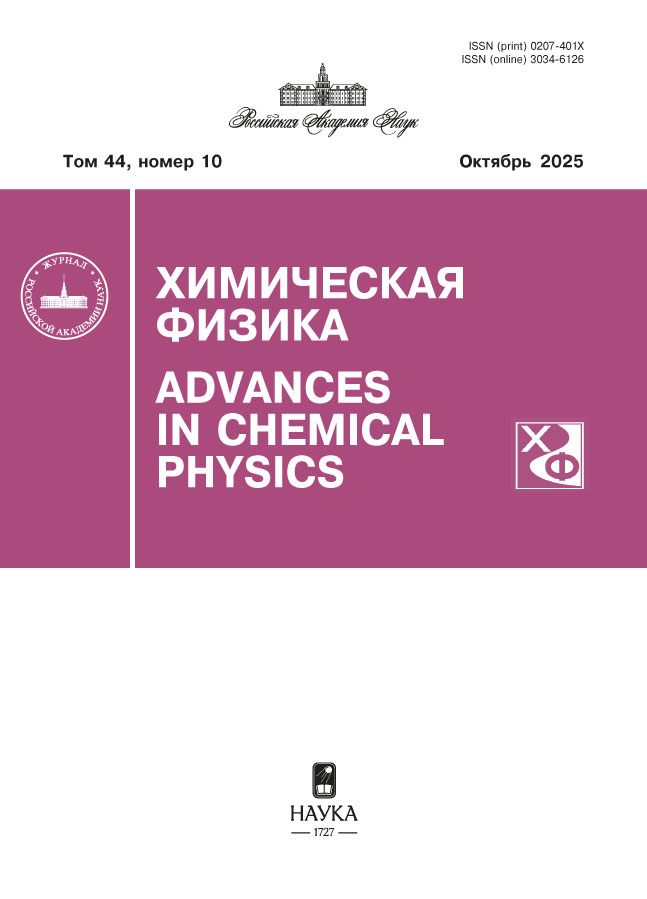Проявление спин-селективности распада синглетных экситонов на пары триплетов в кинетике распада экситонов в пленках рубрена
- Авторы: Шушин А.И.1, Уманский С.Я.1
-
Учреждения:
- Федеральный исследовательский центр химической физики им. Н.Н. Семёнова Российской академии наук
- Выпуск: Том 43, № 12 (2024)
- Страницы: 106-112
- Раздел: Химическая физика наноматериалов
- URL: https://hum-ecol.ru/0207-401X/article/view/684182
- DOI: https://doi.org/10.31857/S0207401X24120106
- ID: 684182
Цитировать
Полный текст
Аннотация
Кинетика распада синлетного возбужденного (S1) состояния (РСС), т.е. расщепление S1 на пару триплетных (Т) экситонов (ТТ-пару), как известно, подвержена существенному влиянию спин-селективной обратной ТТ-аннигиляции (ТТА), которая проявляется в магнитных эффектах в ТТА и, в частности, в магнитозависимости РСС-кинетики. В работе в рамках модели двух состояний (МДС) предложен метод описания магнитных эффектов в РСС-кинетике с корректным учетом стохастической миграции Т-экситонов, проявление которой трактуется как результат переходов между двумя состояниями: [TT]-состоянием взаимодействующих экситонов (на малых Т–Т-расстояниях) и [T+T]-состоянием свободно диффундирующих экситонов (на больших Т–Т-расстояниях). В рамках МДС получено аналитическое выражение для магниточувствительной части РСС-кинетики. Это выражение применено для анализа РСС-кинетики, измеренной в аморфных пленках рубрена в отсутствие магнитного поля (B ≈ 0 и в поле B ≈ 8 кГс.
Ключевые слова
Полный текст
Об авторах
А. И. Шушин
Федеральный исследовательский центр химической физики им. Н.Н. Семёнова Российской академии наук
Автор, ответственный за переписку.
Email: shushin@chph.ras.ru
Россия, Москва
С. Я. Уманский
Федеральный исследовательский центр химической физики им. Н.Н. Семёнова Российской академии наук
Email: shushin@chph.ras.ru
Россия, Москва
Список литературы
- Smith M.B., Michl J.// Annu. Rev. Phys. Chem. 2013. V. 64. P. 361.
- Casanova D. // Chem. Rev. 2018. V. 118. P. 7164. https://doi.org/10.1021/acs.chemrev.7b00601
- Miyata K., Conrad-Burton F.S., Geyer F.L et al.// Chem. Rev. 2019. V. 119. P. 4261. https://doi.org/10.1021/acs.chemrev.8b00572
- Merrifield R.E.//J. Chem. Phys. 1968. V. 48. P. 4318. https://doi.org/10.1063/1.1669777
- Suna A. // Phys. Rev. B. 1970. V. 1. P. 1716. https://doi.org/10.1103/PhysRevB.1.1716
- Shushin A.I. // J. Chem. Phys. 2022. V. 156. № 074703. https://doi.org/10.1063/5.0078158
- Tarasov V.V., Zoriniants G.E., Shushin A.I. et al. // Chem. Phys. Lett. 1997. V. 267. P. 58. https://doi.org/ 10.1016/S0009-2614(97)00056-0
- Ветчинкин А.С., Уманский С.Я., Чайкина Ю.А. и др. // Хим. физика. 2022. Т. 41. № 9. С. 72. https://doi.org/10.31857/S0207401X22090102
- Шушин А.И., Уманский С.Я., Чайкина Ю.А. // Хим. физика. 2023. Т. 42. № 7. С. 86. https://doi.org/10.31857/S0207401X23070178
- Шушин А.И., Уманский С.Я., Чайкина Ю.А. // Хим. физика. 2023. Т. 42. № 12. С. 75. https://doi.org/10.31857/S0207401X23120105
- Уманский С.Я., Адамсон С.О., Ветчинкин А.С. и др. // Хим. физика. 2023. Т. 42. № 4. С. 31. https://doi.org/10.31857/S0207401X23040143
- Ryansnyanskiy A., Biaggio I. // Phys. Rev. B. 2011. V. 84. P. 193203. https://doi.org/10.1103/PhysRevB.84.193203
- Barhoumi T., Monge J.L., Mejatty M. et al. // Eur. Phys. J. B. 2007. V. 59. P. 167.
- Piland G.B., Burdett J.J., Kurunthu D. et al. // J. Phys. Chem. 2013. V. 117. P. 1224. https://doi.org/10.1021/jp309286v
- Pilland G.B., Burdett J.J., Dillon R J. et al. // J. Phys. Chem. Lett. 2014. V. 5. P. 2312. https://doi.org/10.1021/jz500676c
- Shushin A.I. // Chem. Phys. Lett. 1985. V. 118. P. 197. https://doi.org/10.1016/0009-2614(85)85297-0
- Shushin A.I. // J. Chem. Phys. 1991. V. 95. P. 3657. https://doi.org/10.1063/1.460817
- Shushin A.I. // J. Chem. Phys. 1992. V. 97. P. 1954. https://doi.org/10.1063/1.463132
- Steiner U.E., Ulrich T. // Chem. Rev. 1989. V. 89. P. 514. https://doi.org/10.1021/cr00091a003
- Shushin A.I. // Chem. Phys. Lett. 2017. V. 678. P. 283. https://doi.org/10.1016/j.cplett.2017.04.068
- Shushin A.I. // J. Chem. Phys. 2019. V. 151. № 034103. https://doi.org/10.1063/1.5099667
- Blum K. Density Matrix Theory and Applications. New York: Plenum Press, 1981.
Дополнительные файлы












